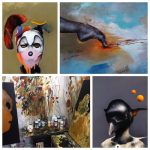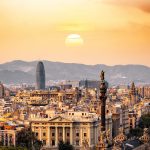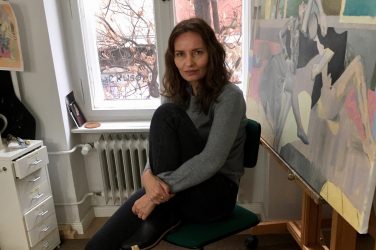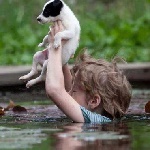E&M‘s Creative Conversations series is back — this time we catch up with Corsican artist Camille Pozzo di Borgo, who spent six months in Milan on an Erasmus placement, and now lives and works in Paris.

Camille’s work depicts hybridized animal forms using the dry point etching technique. Through her artwork, she explores the visceral, brutal and carnal instinct for survival.
In an E&M exclusive, the young artist talks about her promotional use of social media, the themes her work addresses, and her current exhibition in Milan’s Navigli zone.
E&M: Hi Camille, thanks for talking to us. First of all, when did you realise you wanted to be an artist?
Camille: I have been drawing ever since I could hold a pencil.
I knew I wanted to work in the artistic field since I was a child, I drew every day, and it was my first passion. But it was only when I moved to Paris, and after I finished my first year in the preparatory school of fine arts “l’atelier de Sèvres”, I realized I would like to become an artist.
E&M: What can you tell us about your time in Milan? How did it help you develop as an artist?
Camille: My six months of Erasmus in Italy were rich in exchange, learning and traveling, and visiting museums.
It is a city that I loved. It is alive. If there is indeed a place in Italy where you have to study or live, it has to be Milan, which is not a city known for its monuments.
I was at the Academia di Belle Arti di Brera, I found the teaching of this school too academic, there was no workshop to work, it slowed me down in my creative process.
Nevertheless, my visit to this establishment allowed me to acquire new practices such as gilding, or to travel to northern Italy, the so-called culla dell’arte (cradle of art), which seems important to me to know.
A stay in Italy is essential because of the amount of renaissance museums, but for me it lacks something in contemporary art.
In my opinion, this is not the place to be when you want to become an artist. In spite of that, this experience allowed me to meet a very interesting couple of gallery owners who proposed me an exhibition from March 6th to April 28th, in the Area35 Gallery in Milan.
Paris is, for me, probably one of the most beautiful cities in the world
E&M: What inspired you while you were in Milan?
Camille: Gilding, Italian renaissance, and strong culture all inspired me.
E&M: As a young artist, what is the best thing about Milan, and the worst?
Camille: The quality of life is great, la dolce vita, museums, galleries, trips and, of course, aperitivo.
Bad points: the teaching is poor; the south of Europe is not famous for its arts schools.
E&M: What about Paris? How do you find the city as a young artist?
Camille: It is great—there are lots of museums, galleries, artists to discover. Paris is, for me, probably one of the most beautiful cities in the world.
E&M: Where would be your ideal place to exhibit your work?
Camille: London, New York, Berlin and Paris are the most active places in the art world, but I’m prepared to exhibit anywhere in the world.
I experimented with various techniques that led me to dissect the animals in different forms, from the naturalized animal to the dissected animal; I finally became interested in the bestial aggressiveness of movement
E&M: What is the best European city for art, right now?
Camille: I would say Berlin.
E&M: Who is your biggest inspiration/influence?
Camille: The artist Walton Ford influences me. The hunting museum in Paris and the natural history museums are real sources of inspiration for my work.
E&M: What themes do approach in your work? What interests you about animals, as a subject matter?
Camille: My work has been developing for many years around the animal world. My vision of these beings is multi-faceted—since I am interested in both their fleshy exteriors, which the human eye sees, and their interiors, which lie beneath.
I experimented with various techniques that led me to dissect the animals in different forms, from the naturalized animal to the dissected animal; I finally became interested in the bestial aggressiveness of movement.
I focus more specifically on the aggressiveness that stems from their instincts of survival. I like to tap into this.
I play on the transparency and the deformation of these beings by decomposing and meticulously superimposing their movements by means of engravings on plexiglass.
I focus on their gestures during a fight, a movement or courtship to create the illusion that the animal is fighting against itself, creating at the same time an imaginary, hybridized creature.
Creating several layers, by superimposing different mediums, allows me to stage new confrontations with each impression. I address the question of the necessity of animal violence, and the action of surviving by killing.

E&M: What are your favourite mediums to work with?
Camille: I work with the help of the dry point etching process. This technique allows me to construct several layers, develop fineness of line, and it gives me a choice of multiple colours.
E&M: How easy is it to be a young artist these days? Does the modern age of social media help you?
Camille: I think there’s no such thing as a good time to be an artist. It’s very stressful on many levels, financially, the fear of the blank page and the fear of the future.
It takes courage, a lot of work and, if possible, financial support. Of course social networks are favourable to promote emerging artists, they open a window to our work to make it more visible and more accessible to the general public.
E&M: What do you think about modern ways of selling art? Using Instagram, for example?
Camille: I find it very convenient. Although I have not yet understood how to sell on Instagram, I just started to use the “#”.
E&M: Does your Instagram help you to sell your art?
Camille: I had a lot of requests via Instagram, but still no sales. But they will come.
E&M: Do you have any exhibitions coming up you can tell us about?
Camille: I am currently exhibiting in Milan in the Area35 Gallery near Navigli until April 28th.
I am also involved in the planning of an exhibition of young artists in the gallery Forest Divonne, next to the Beaux Arts in Paris. This exhibition will take place from May 17th to June 9th.


Cover photo courtesy: Camille Pozzo di Borgo










